Samsung SSD 840 Pro (256GB) Review
by Anand Lal Shimpi on September 24, 2012 7:00 AM EST- Posted in
- Storage
- SSDs
- Samsung
- Samsung SSD 840
Random Read/Write Speed
The four corners of SSD performance are as follows: random read, random write, sequential read and sequential write speed. Random accesses are generally small in size, while sequential accesses tend to be larger and thus we have the four Iometer tests we use in all of our reviews.
Our first test writes 4KB in a completely random pattern over an 8GB space of the drive to simulate the sort of random access that you'd see on an OS drive (even this is more stressful than a normal desktop user would see). I perform three concurrent IOs and run the test for 3 minutes. The results reported are in average MB/s over the entire time. We use both standard pseudo randomly generated data for each write as well as fully random data to show you both the maximum and minimum performance offered by SandForce based drives in these tests. The average performance of SF drives will likely be somewhere in between the two values for each drive you see in the graphs. For an understanding of why this matters, read our original SandForce article.
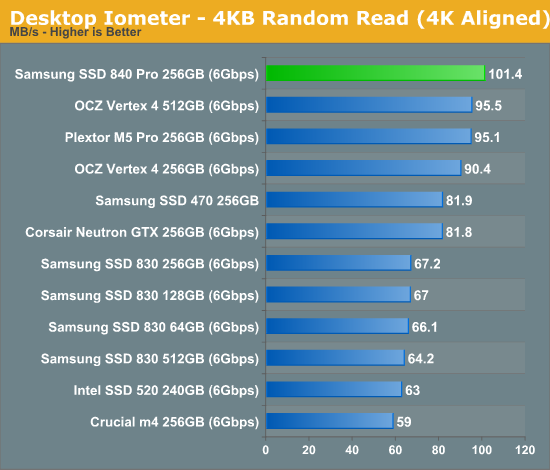
We have a new king, the 840 Pro manages to inch past the fastest Vertex 4 in our random read performance test.
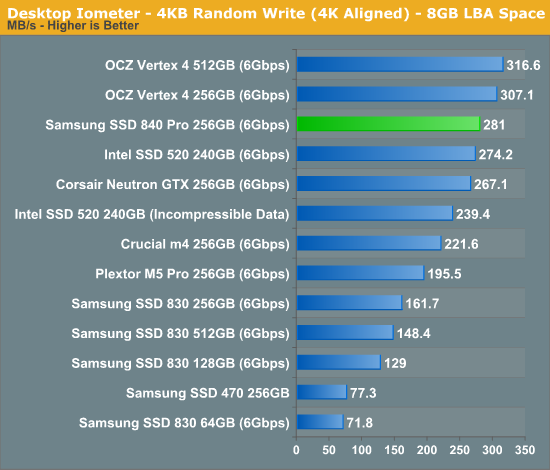
The low queue depth random write performance crown goes back to the Vertex 4, but the 840 Pro is around 75% faster than the old 830. Other than the Vertex 4, there's nothing faster than the 840 Pro here.
Many of you have asked for random write performance at higher queue depths. What I have below is our 4KB random write test performed at a queue depth of 32 instead of 3. While the vast majority of desktop usage models experience queue depths of 0 - 5, higher depths are possible in heavy I/O (and multi-user) workloads:
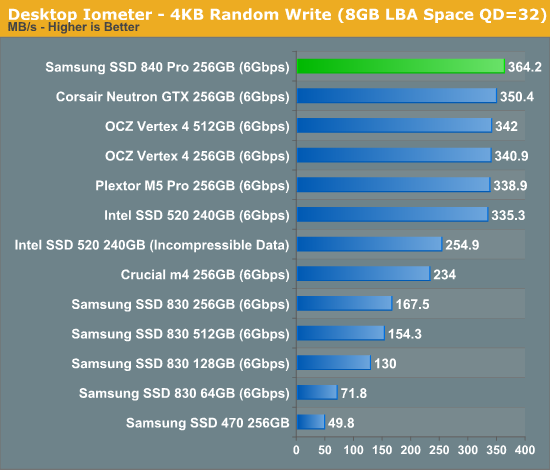
Ramp up queue depth and the 840 Pro manages to even outperform Corsair's new Neutron GTX.
Sequential Read/Write Speed
To measure sequential performance I ran a 1 minute long 128KB sequential test over the entire span of the drive at a queue depth of 1. The results reported are in average MB/s over the entire test length.
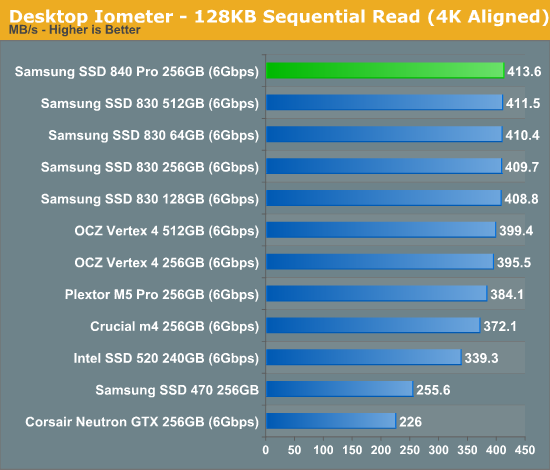
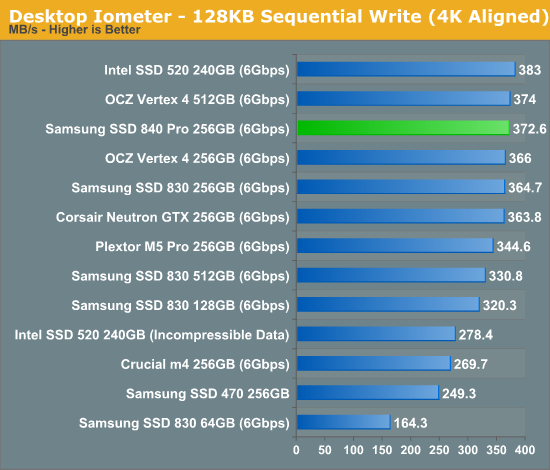
There are no tradeoffs here: excellent random IO performance and class leading low queue depth sequential performance. The 840 Pro is looking like a good all-around performer.
AS-SSD Incompressible Sequential Performance
The AS-SSD sequential benchmark uses incompressible data for all of its transfers. The result is a pretty big reduction in sequential write speed on SandForce based controllers.

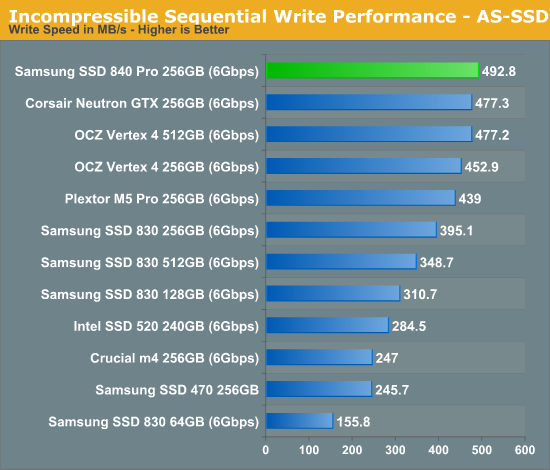
The 840 Pro lands on top once again in these higher queue depth sequential tests. The competition is hot on the heels of the 840 Pro however, we're limited by 6Gbps SATA here so expect continued clustering around 500MB/s going forward.










96 Comments
View All Comments
Pneumothorax - Monday, September 24, 2012 - link
While the 840 Pro kicks ass, I wonder if the 3bpc 840 is going to have less endurance while offering the same performance as the previous gen 830 drive... If that's the case buy them up while they're on sale in the next few months before they run out. Unless another SSD maker comes out with a drive that tops the 840 Pro, it's going to command a premium price per gb for some time.Pixelpusher6 - Monday, September 24, 2012 - link
I ended up buying a Samsung 830 about a year ago and I have absolutely loved it, fast performance plus rock stable. I might consider grabbing one of these when the price comes down a bit.I was wondering if say Samsung or any other SSD manufacturer didn't care about power consumption as much, and say clocked those 3 cortex A9 cores @ 700Mhz instead of 300, would 4k random performance increase significantly? Or are these SSDs mainly limited by firmware still even at 300Mhz, so increasing the clockspeed won't have much impact. What about if they added a 4th core instead of increase clock speed?
apmon2 - Monday, September 24, 2012 - link
I would be interested to see numbers for the 840 pro and other SSDs for random 4k read performance at high queue depth.On my Samsung 32Gb msata SSD I get about 60Mb/s of 4kb random read at queue depth of 1. However at e.g. queue depth of 10 I see random read rates of over 250Mb/s!
I don't know how typical hi depth 4kb random read are on desktop loads, but for server applications like e.g. databases it is pretty common.
frombauer - Monday, September 24, 2012 - link
... to replace my aging Intel 320 series (300GB). Just wondering if it will make a tangible (in my eyes) difference in day to day use, since I don't care about benchmarking. Maybe it will be better to pick up a cheaper 830 which is proven to be reliable... either way, the Intel will go to my PS3 since I'm pretty sure it will be nearly useless to sell in the used market.Old_Fogie_Late_Bloomer - Monday, September 24, 2012 - link
I'm kind of in a similar boat, kind of wanting to upgrade my desktop's 160GB 320 with a drive that's faster and a bit more spacious. I had paired it with a 64GB Samsung 830 to free up the space used by the memory swap file, but I probably wouldn't do that if I got a larger drive.I could probably use the 64GB drive for my Steam folder, but I'd still be left with the 160 GB 320, as well as another 40 GB 320...it's like, what would I use those drives for? I guess I could hang onto them for when I get around to building a Linux box...
FunBunny2 - Monday, September 24, 2012 - link
-- I had paired it with a 64GB Samsung 830 to free up the space used by the memory swap fileI've always wondered: a swap file gets hammered, so when partitioning a drive with some swap and some user file system, does leveling only happen *within* the user defined partition? Or does the controller (or varying by controller) level across devices without regard to partitions?
If not, then a sacrificial small drive as swap is much safer.
DanNeely - Monday, September 24, 2012 - link
WIth any modern SSD there's no correlation between where a file is located on the nand ships and the location the file system driver is telling the SSD to write to.Old_Fogie_Late_Bloomer - Monday, September 24, 2012 - link
I had thought about that as well, when I decided to move the swap file; I wish Windows would let you move the hibernate image file too, for the same reason. That being said, though...I'm just not that worried about it, anymore. I don't think swap files or even hibernating your computer are going to do your SSD in prematurely.iamezza - Monday, September 24, 2012 - link
There really wouldn't be any difference in day to day usage, unless you have some really out of the ordinary patterns. Most day to day stuff will hardly stress an SSD at all.Old_Fogie_Late_Bloomer - Monday, September 24, 2012 - link
Really? 'Cause I have to say I never felt that the 320 quite lived up to all the hype about SSDs. And the sequential read times of the 840 should be significantly higher than those of the 320, right? Meaning that your boot times, application load times, level load times, etc. should be noticeably faster?